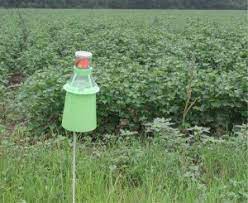Integrated Pest Management and Symptoms of Plant Diseases
Integrated Pest Management (IPM) can be defined as the judicious selection and use of compatible control options to keep pest population below damaging levels.
IPM is based on knowledge of the ecology and population dynamics of the pest and its natural enemies. The emphasis here is on controlling pests rather than attempting to eradicate them altogether.
Plant Diseases
Plant diseases can be defined in the widest sense as conditions of the plant involving abnormalities of growth or structure. It is this departure from the normal healthy condition, resulting in the appearance of disease symptoms, which enables diseases to be recognized.
There are many factors which cause plants to appear unhealthy. Diseases may be caused by pathogens. These are parasitic organisms which live in or on the host plant and cause the appearance of disease symptoms; this process is called pathogenesis.
Plants may also be damaged by pest and mechanical forces, such as wind, hail and farm implements.
There are non-parasitic diseases or disorders which are caused either by adverse environmental conditions or by internal physiological disturbances, usually of genetic origin.
These include climatic damage due to frost, sun or lightning; mineral deficiencies or imbalances and genetic mutations. Parasitic diseases are important because they are infectious – they can spread between plants, often rapidly and extensively, and frequently produce epidemics.
The most important effect of plant diseases for the farmer is the reduction in crop yield or quality which results.
Read Also : The Direct and Indirect Effects of Pests on Crop Plants
Symptoms of Plant Diseases

Many diseases can be recognized immediately by the characteristic symptoms which they produced. Symptoms are usually described according to their appearance.
Thus, changes of foliage color may involve chlorosis (yellowing), mottled patterns as in mosaics or leaf stripe diseases, or the complete death of areas of tissues (necrosis). Symptoms of plant disease can be divided into two groups.
Localized symptom, involve small parts of individual plant organ, such as leaf spots or whole plant organs, such as root rots and blights.
Systemic symptoms are those which affect the whole plant, such as wilts and general stunting.
Symptoms of Plant Diseases
Death of the tissues or necrosis: various terms are used to describe the extent and shape of necrotic lesions, particularly on leaves, stripe for narrow, elongated lesions, scorch, scald, fire and blotch for indefinite areas which often becomes blanched and then brittle, and leaf spot for well-defined lesions of limited extent.
An abnormal increase in the tissues: this can result from both an increase in size (hypertrophy) and an increase in number (hyperplasia) of cells. The more common symptoms of this type are witches brooms, galls, canker and scab.
A failure to attain normal size or development (hypoplasia): An overall dwarfing or stunting of the plant is common in many diseases.
Change in color: yellowing or chlorosis is a common symptom of disease and one is often associated with tissue surrounding a necrotic area.
Wilting, caused by an interference with the normal movement of water within the plant.
Unusual development or transformation of organs: for example maize infected with Ustilago maydis the staminate inflorescences may bear pistillate flowers.
Disintegration of tissues: this is termed rot. It may be accompanied by a release of cell fluids (wet rot), so much so that there is an exudates from partially disintegrated tissue. Alternatively, the cells may crumble to a powdery mass (dry rot).
Excessive gum formation: this is particularly associated with diseases of trees and is known as gummosis or gumming.
Read Also : Consumable Waste Complete Management Guide









